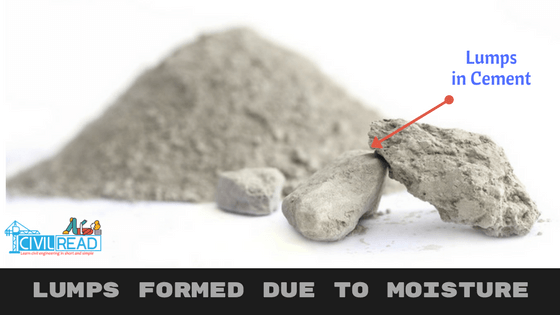Contents
Quality of cement on site :-
Cement is the most used material in any construction. It acts as a binder which binds aggregate and sand together in concrete. Well, there are so many theories explained how to check the quality of cement in the lab but most of them require huge apparatus to check the quality of cement.
It is not easy to check all properties of cement on the site but there exist some preliminary field tests which can give us a rough idea about the quality of cement.
Below mentioned tests are the simple tests which you can perform easily on site to find out the quality of cement with no apparatus. These preliminary tests include checking the properties of cement which affect the Cement strength and quality.
1. Date of Packing (MFG Date):
Several studies stated that as the Strength of cement reduces as time goes on. As per IS Specifications cement should be re tested if it is stored more than three months in the mill.
The below table gives details about the percentage of strength loss for different time intervals.
| Age of cement | Percentage of Cement Strength reduction |
|---|---|
| 3 months | 20%-30% |
| 6 months | 30%-40% |
| 12 months | 40%-50% |
From the above table, it is clear that strength of cement loses its strength over a period of time.
2. Colour of Cement: –
The colour of cement should be uniform. An ideal colour of cement is grey with a light greenish shade. Cement colour gives an indication of excess clay or lime.

3. Check for lumps:-
Lumps are formed due to the presence of moisture in cement. Cement undergoes a chemical reaction when it is reacted with the atmospheric moisture this process is termed as hydration. Moisture is a big enemy for cement. Cement becomes useless once it is hydrated with water (liquid form or vapour form)

4. Rubbing Test:
Take a pinch of cement rub within your fingers, it should feel smooth while rubbing. If it is rough, it indicates that cement is mixed with sand.
5. Float test of cement :-
Take a handful of cement and throw it in water, a good quality of Cement should sink and should not float on water.
6. Hand insertion:-
Insert your hand into the cement bag. It must give you a cool feeling. It implies that the no hydration reaction taken place in cement bag,
7. Shape test of cement:-
Cement is also named as Hydraulic Cement as it also sets under water.
Take a 100g of cement and make a stiff paste by adding some water. Then prepare a cement cake with sharp edges and place it on a glass plate. Immerse this plate in the water bucket. Observe that the shape shouldn’t get disturbed while settling. A good cement should be able to set and attain strength in water.
8. Strength test: –
Make A block of cement 25 mm x 25 mm and 200 mm long. Immerse the block in water for 7 days. Place the immersed block on supports 15000 mm apart and then load with a weight of 340 N. the block which is made of good cement should not show any sign of failure.
9. Specific Gravity of cement:-
Finding specific gravity of cement is utmost important if cement is stored for more than three months. A good cement should have Specific gravity (Sg) in between 3.1-3.6g/cc. For more details on test procedure of specific gravity refer here
You may Also Read:
How to check quality of sand on site
Checking quality of bricks on site.
Slump test procedure and its applications
For Instant updates Join our Whatsapp Broadcast. Save our Whatsapp contact +919700078271 as Civilread and Send us a message “JOIN“
Never Miss an update Click on “Allow US“ and make us allow or Click on
Red notification bell at bottom right and allow notifications. Stay tuned!
Civil Read Wishes you ALL the BEST for your future..
Share With Your Friends| Sharing Is Caring:)




This blog is useful for some extra tips on regular unorthodox methods, but very efficient. Thanks for all the efforts guys.
Very much awesome Sir. Congratulations for great work. Please continue doing. I have a question what is temperature maintained during placing of fresh concrete?
hi i request you to post ur query on forum.civilread.com so i get back to u asap
While placing concrete the temperature is in between 60Degree to 80Degree Fahrenheit
always be practical and use common language of civil engg. like degree celsius is common to fahrenheit . like 27 degrnsee celsius mean 80 degree fahrenheit . and 27 degree is just about normal temp
Celsius and Fahrenheit is just a conversion use google converter for this. I mostly use Fahrenheit scale so i wrote same hope u got it.
Great job sir..this is very helpful for all civil engineers.thanks.
good work..simple for freshers..keep updating
VERY GOOD BRO!
IT IS VERY HELPFUL TO COMMON PEOPLES TO KEEP AN EYE WITH THEIR NEEDS IN A PROFESSIONAL MANNER.
ALWAYS WE WILL WITH YOU.
IF YOU DON’T MIND SEND YOUR CONTACT FOR A BETTER NETWORK.
#ENGINEERING FROM KERALA